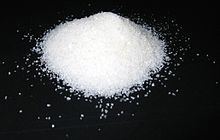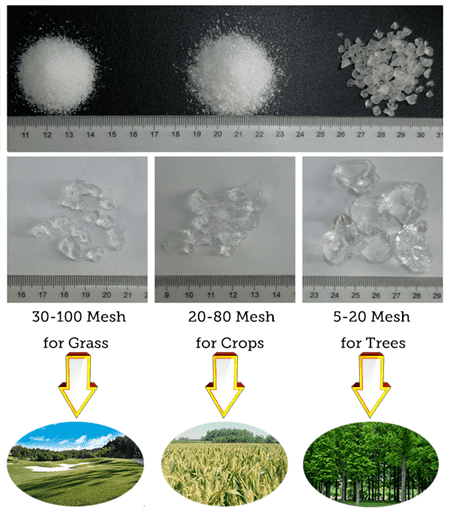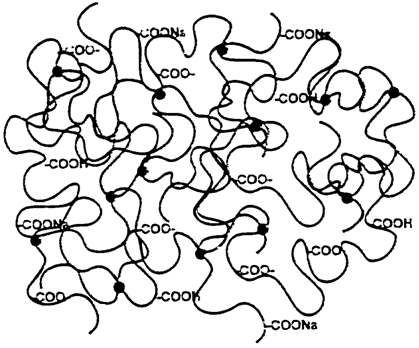 | ||
Superabsorbent polymer instant snow
Superabsorbent polymers (SAPs) (also called slush powder)can absorb and retain extremely large amounts of a liquid relative to their own mass.
Contents
- Superabsorbent polymer instant snow
- Superabsorbent polymer chemical reaction
- History
- Copolymer chemistry
- Gel polymerization
- Solution polymerization
- Suspension polymerization
- References

Water-absorbing polymers, which are classified as hydrogels when cross-linked, absorb aqueous solutions through hydrogen bonding with water molecules. A SAP's ability to absorb water is a factor of the ionic concentration of the aqueous solution. In deionized and distilled water, a SAP may absorb 300 times its weight (from 30 to 60 times its own volume) and can become up to 99.9% liquid, but when put into a 0.9% saline solution, the absorbency drops to maybe 50 times its weight. The presence of valence cations in the solution impedes the polymer's ability to bond with the water molecule.

The total absorbency and swelling capacity are controlled by the type and degree of cross-linkers used to make the gel. Low-density cross-linked SAPs generally have a higher absorbent capacity and swell to a larger degree. These types of SAPs also have a softer and stickier gel formation. High cross-link density polymers exhibit lower absorbent capacity and swell, but the gel strength is firmer and can maintain particle shape even under modest pressure.

The largest use of SAPs is found in personal disposable hygiene products, such as baby diapers, adult protective underwear and sanitary napkins. SAP was discontinued from use in tampons due to 1980s concern over a link with toxic shock syndrome. SAP is also used for blocking water penetration in underground power or communications cable, horticultural water retention agents, control of spill and waste aqueous fluid, and artificial snow for motion picture and stage production. The first commercial use was in 1978 for use in feminine napkins in Japan and disposable bed liners for nursing home patients in the USA. Early applications in the US market were with small regional diaper manufacturers as well as Kimberly Clark, with advancements made quickly with the process breakthrough of proper product placement at the optimal depth in the media.

Superabsorbent polymer chemical reaction
History
Until the 1920s, water absorbing materials were cellulosic or fiber-based products. Choices were tissue paper, cotton, sponge, and fluff pulp. The water absorbent capacity of these types of materials is only up to 11 times their weight, but most of it is lost under moderate pressure.

In the early 1960s, the United States Department of Agriculture (USDA) was conducting work on materials to improve water conservation in soils. They developed a resin based on the grafting of acrylonitrile polymer onto the backbone of starch molecules (i.e. starch-grafting). The hydrolyzed product of the hydrolysis of this starch-acrylonitrile co-polymer gave water absorption greater than 400 times its weight. Also, the gel did not release liquid water the way that fiber-based absorbents do.

The polymer came to be known as “Super Slurper”. The USDA gave the technical know-how to several USA companies for further development of the basic technology. A wide range of grafting combinations were attempted including work with acrylic acid, acrylamide and polyvinyl alcohol (PVA). Today´s research has proved the ability of natural materials, e.g. Polysaccharides and Proteins, to perform super absorbent properties in pure Water and saline solution (0,9%wt.) within the same range as synthetic polyacrylates do in current applications. Polyacrylate/polyacrylamide copolymers were originally designed for use in conditions with high electrolyte/mineral content and a need for long term stability including numerous wet/dry cycles. Uses include agricultural and horticultural. With the added strength of the acrylamide monomer, used as medical spill control, wire & cable water blocking
Copolymer chemistry

Superabsorbent polymers are now commonly made from the polymerization of acrylic acid blended with sodium hydroxide in the presence of an initiator to form a poly-acrylic acid sodium salt (sometimes referred to as sodium polyacrylate). This polymer is the most common type of SAP made in the world today.
Other materials are also used to make a superabsorbent polymer, such as polyacrylamide copolymer, ethylene maleic anhydride copolymer, cross-linked carboxymethylcellulose, polyvinyl alcohol copolymers, cross-linked polyethylene oxide, and starch grafted copolymer of polyacrylonitrile to name a few. The latter is one of the oldest SAP forms created.
Today superabsorbent polymers are made using one of three primary methods: gel polymerization, suspension polymerization or solution polymerization. Each of the processes have their respective advantages but all yield a consistent quality of product.
Gel polymerization
A mixture of acrylic acid, water, cross-linking agents and UV initiator chemicals are blended and placed either on a moving belt or in large tubs. The liquid mixture then goes into a "reactor" which is a long chamber with a series of strong UV lights. The UV radiation drives the polymerization and cross-linking reactions. The resulting "logs" are sticky gels containing 60-70% water. The logs are shredded or ground and placed in various sorts of driers. Additional cross-linking agent may be sprayed on the particles' surface; this "surface cross-linking" increases the product's ability to swell under pressure—a property measured as Absorbency Under Load (AUL) or Absorbency Against Pressure (AAP). The dried polymer particles are then screened for proper particle size distribution and packaging. The gel polymerization (GP) method is currently the most popular method for making the sodium polyacrylate superabsorbent polymers now used in baby diapers and other disposable hygienic articles.
Solution polymerization
Solution polymers offer the absorbency of a granular polymer supplied in solution form. Solutions can be diluted with water prior to application, and can coat most substrates or used to saturate them. After drying at a specific temperature for a specific time, the result is a coated substrate with superabsorbency. For example, this chemistry can be applied directly onto wires and cables, though it is especially optimized for use on components such as rolled goods or sheeted substrates.
Solution-based polymerization is commonly used today for SAP manufacture of co-polymers, particularly those with the toxic acrylamide monomer. This process is efficient and generally has a lower capital cost base. The solution process uses a water-based monomer solution to produce a mass of reactant polymerized gel. The polymerization's own exothermic reaction energy is used to drive much of the process, helping reduce manufacturing cost. The reactant polymer gel is then chopped, dried and ground to its final granule size. Any treatments to enhance performance characteristics of the SAP are usually accomplished after the final granule size is created.
Suspension polymerization
The suspension process is practiced by only a few companies because it requires a higher degree of production control and product engineering during the polymerization step. This process suspends the water-based reactant in a hydrocarbon-based solvent. The net result is that the suspension polymerization creates the primary polymer particle in the reactor rather than mechanically in post-reaction stages. Performance enhancements can also be made during, or just after, the reaction stage.
